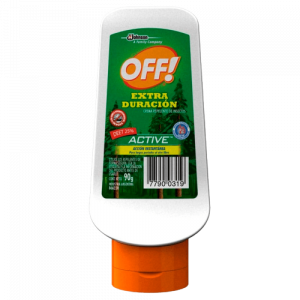OFF extra duración crema repelente de insectos
6.8

Ingredientes
Diethyl toluamide
Ingrediente sospechado de ser severamente tóxico ante ingesta, potencialmente tóxico a nivel reproductivo, sensibilizador de la piel, peligroso para la vida acuática y con efectos duraderos en el ambiente.
water
Ingrediente generalmente considerado seguro para su uso en productos de Belleza y Cuidado Personal.
stearyl alcohol
Ingrediente generalmente considerado seguro para su uso en productos de Belleza y Cuidado Personal, en las condiciones actuales de concentración y prácticas de uso. Sin embargo, la sobreexposición a este ingrediente puede irritar la piel.
POLYETHYLENE
Ingrediente (microplástico) potencialmente peligroso para el ambiente.
PPG-15 Stearyl ether
Ingrediente potencialmente irritante para la piel y peligroso para la vida acuática.
triethanolamine
Existen restricciones en cuanto a la concentración máxima permitida y el tipo de formulaciones en los que puede utilizarse este ingrediente. Potencialmente irritante y sensibilizador de la piel y del sistema respiratorio.
glyceryl stearate
Ingrediente clasificado como seguro para su uso como ingrediente cosmético.
Glycol Stearate
Ingrediente potencialmente irritante para la piel y peligroso para la vida acuática.
carbomer
Ingrediente generalmente considerado seguro para su uso en productos de Belleza y Cuidado Personal. Sin embargo, estos polímeros (o microplásticos) han mostrado efectos adversos sobre el ambiente y la vida acuática.
methyl
-
methylparaben
Ingrediente (parabeno) potencialmente estrogénico (en proceso de evaluación).
perfume
El contacto directo con ciertas fragancias o aromas sintétocos inespecíficos puede ocasionar alergias, irritar o sensibilizar la piel.
Más información
El análisis de ingredientes ha sido elaborado por investigadores del CONICET (*) en base a las siguientes referencias bibliográficas:
- European Commission Legislation (Regulation (EC) N° 1223/2009 y 2019/831, Annexes I to VI and all the amendments to the cosmetics regulation).
- Material Safety Data Sheet MSDS# 112-92-5
- CIR (Cosmetic Ingredient Review). Annual Review of Cosmetic Ingredient Safety Assessments (2004/2005).
- International Journal of Toxicology, 25(2):1–89, 2006
- Cosmetic Ingredient Review (CIR), Safety Assessment of Polyene Group as Used in Cosmetics Report (2015)
- Material Safety Data Sheet MSDS# 23930
- https://www.cosmeticsinfo.org/ingredient/triethanolamine.
- Stout, M. D., Kissling, G. E., Suárez, F. A., Malarkey, D. E., Herbert, R. A., & Bucher, J. R. (2008). Toxicologic pathology, 36(6), 783-794.
- ACGIH, IARC, NTP, or CA Prop 65.
- K. Aschenbeck, E. Warshaw. Allergenic Ingredients in Facial Wet Wipes. Dermatitis (2017) 28(6):353–359
- A. C. de Groot, H. L. M. van der Meeren, J. Willem Weyland. Contact Dermatitis (1988) 19: 77-78
- Cosmetic Ingredient Review (CIR)
- Final Report of the Amended Safety Assessment (2004). International Journal of Toxicology, 23 (2), 55–94.
- CIR (Cosmetic Ingredient Review). Safety Assessment of Acrylates Copolymers as Used in Cosmetics (2018).
- Rillig, M. C., et al. (2019). Microplastic effects on plants. New Phytologist, 223(3), 1066-1070.
- Sussarellu, R., et al. (2016). Oyster reproduction is affected by exposure to polystyrene microplastics. Proceedings of the National Academy of Sciences, 113(9), 2430-2435.
- SCCNFP (The Scientific Committee on Cosmetic Products and Non-Food Products Intended for Consumers) 1999. Opinion concerning fragrance allergy in consumers. A review of the problem. Analysis of the need for appropriate consumer information and identification of consumer allergens. SCCNFP/0017/98 Final. December 199 - Tatyana Hamilton and Gillian C de Gannes. 2011. Allergic contact dermatitis to preservatives and fragrances in cosmetics. Skin therapy letter 16(4), 1-4 .- Anne Birgitte Simonsen, Mette Deleuran, Jeanne Duus Johansen and Mette Sommerlund 2011. Contact allergy and allergic contact dermatitis in children - a review of current data. Contact dermatitis 65(5), 254-65.
(*) Según el ranking SCImago 2020, el CONICET alcanza la segunda posición entre las instituciones académicas y de investigación más prestigiosas de América Latina. A nivel mundial, ocupa la posición 230 entre 7000 instituciones privadas y gubernamentales.
